Building materials
Brick
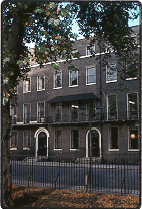
- Naked grey brick
- Naked grey brick in Bloomsbury Square, London (photo J. Carré).
[click on the picture to enlarge it]
Brick was the most common building material in Georgian cities. It was now preferred to other materials because it was cheap, easy to produce anywhere and fire-resistant. This last reason appeared specially important after the Great Fire of London in 1666, and the Act for the Rebuilding of the City of London actually prohibited the use of timber and plaster for the fronts of all types of houses, thus encouraging the choice of brick. Around the capital and the major cities could then be seen increasingly numerous brick-yards recognizable by their smoking kilns.
Clay always entered the composition of brick in varying degrees, but there were various qualities and colours. The best and worst bricks were described by the architect Isaac Ware in 1756 in the following manner:
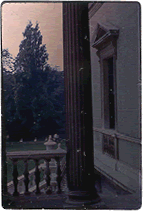
- ’Rendered’ brick
- ’Rendered’ brick at Chiswick Villa, Middlesex (1728) (photo J. Carré).
[click on the picture to enlarge it]
The grey stocks are made of a purer earth, and better wrought, and they are used in front in building, being the strongest and handsomest of this kind; the place bricks are made of the clay with a mixture of dirt and other coarse materials, and are more carelessly put out of hand; they are therefore weaker and more brittle, and are used out of sight, and where little stress is put upon them (A Complete Body of Architecture, 1756).
In spite of their name the ’grey-stocks’could be yellowish or reddish as well as grey. Most of the brick walls were left naked, giving cities like London and Dublin their characteristic appearance. But in the public or more elegant private buildings the brick was often ’rendered’ (coated with cement) to imitate stone, as in Lord Burlington’s Chiswick Villa. Later in the century, brick was often stuccoed, which gave the buildings the kind of smooth texture required by neo-classical architects. John Nash’s palatial terraces around Regent’s Park are a good example of this.
Stone
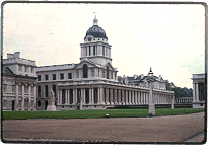
- Roche Abbey limestone
- Roche Abbey limestone at Greenwich Hospital (1699) (photo J. Carré).
[click on the picture to enlarge it]
Stone served as the main building material in Georgian cities only when it was easily available locally, and therefore less expensive. Otherwise it was used only in public buildings and the façades of the more expensive private houses. Even in such cases its was often mostly reserved for columns, pediments, door-cases, window-frames, cornices and mouldings, while the walls were made of brick. In England, limestone and sandstone were the two types of building stone most commonly found, but not always within easy reach of cities. Materials like flint and chalk, formerly much used in rural housing, were not favoured in urban building. Flint obviously did not lend itself to the smooth finishing expected in classical architecture. Chalk, the variety of limestone easiest to carve, was not very resistant, and required frequent repairs. In Scotland and Cornwall, granite was often available and was commonly used in cities like Aberdeen.
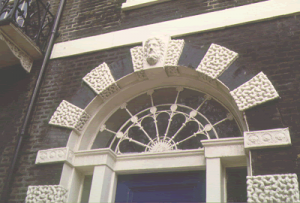
- Bedford Square
- [click on the picture to enlarge it]
Olite limestone proved a generally reliable material, and was widely used in those English cities where it could be found in the neighbourhood. Such was for example the case of Stamford, Cheltenham, and, of course, of Bath, where local quarries of yellow oolite limestone provided an attractive (although porous) and reasonably cheap material. Bath stone was not used only locally, but, especially after the opening of the Kennet and Avon canal, sold in London and the South-East. Lincolnshire limestone was of even better quality, and used in many East Anglian cities in the 18th century. Most Cambridge colleges are faced with stone from the Ketton quarries, and Wren chose it for Trinity College Library. “Its even, regular texture renders it particularly suitable for buildings designed in a precise, Classical style” (A. Clifton-Taylor). Yet the best of all limestones used in Georgian England was Portland stone from the Dorset coast. It was much favoured because of its attractive whitish colour, its resistance to the weather and to pollution, and also because it could be obtained in very large blocks. It could be conveniently shipped to all parts of the British Isles, and was much sought after, particularly in London and Dublin, for public buildings. Wren chose it for St Paul’s Cathedral and the steeples of many of his City churches. In the cities of the North-East, such as York and Beverley, magnesian limestone was often used for public buildings and the more expensive private houses. Roche Abbey stone was of particularly high quality and was used as far as the South-East. Wren thought highly of it and chose it for Greenwich Hospital (1699).
Often less resistant than limestone, sandstone was nevertheless used in many provincial Georgian cities because of its local availability. It had considerable visual qualities, being deep-hued, like the brownish ’carstone’, thanks to various oxides, and often had a slight sparkle due to the presence of quartz. It could easily give individuality to a city, such as Tunbridge Wells, built with Wealden sandstone, and Edinburgh, whose ’New Town’was entirely built of carboniferous sandstone from the neighbouring quarries at Craigleith. But some varieties were disastrously soft, and proved costly in the long run. Thus St Philip’s Cathedral, in Birmingham, finished in 1725, had to be entirely refaced in the mid 19th century.
Artificial stone or Coade stone
The least-known material used in building Georgian cities was artificial stone. It was not used to build walls, but mainly to provide cheap architectural ornaments such as mouldings, capitals, and occasionally statuary. The material was patented by Richard Holt as early as 1722, and advertised in his Short Treatise of Artificial Stone (1730). Faced with the competition of Batty Langley, Holt at first kept the composition of his material secret. We now know it was made of clay compounded with finely ground glass and lead ores. It was not before the 1770s, however, that artificial stone was used on a large scale in British cities. The most successful firm was then Mrs Coade’s in Lambeth, London -hence the name of ’Coade stone’. John Summerson has drawn an impressive list of London buildings where it was used for decorative or restoration purposes in the last quarter of the 18th century: From Buckingham Palace to Twining’s tea-warehouse in the Strand, from Westminster Abbey to the chapel-of-ease in the Hampstead Road, from the Bank of England and the Royal Exchange to the impost mouldings on the doorways of Bedford Square, Coade Stone was triumphant.
Cast iron
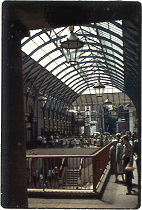
- Cast-iron
- Cast-iron at Covent Garden Market (1828) (photo J. Carré).
[click on the picture to enlarge it]
Britain’s pioneering role in the industrial production of iron enabled some adventurous engineers and architects to use cast iron as a building material in a structural capacity from the 1770s. But the material had been used long before for decorative purposes, gradually supplanting the more expensive wrought iron during the course of the 18th century. The railings around Wren’s St Paul’s Cathedral, and those around Gibbs’s St Martin-in-the-Fields in London were already made of cast iron. But it was in the late Georgian age, when the material was cheaper, that it triumphed in domestic ornament. Designs were provided in specialized pattern-books such as I. and J. Taylor’s Ornamental Iron Work, or Designs in the Present Taste, for Fan-Lights, Stair-case railing. Window-guard-irons, Lamp-irons, Palisades, & Gates (1790).
The use of cast-iron as a building material in a structural capacity came even later in the Georgian age, and was at first reserved to engineering work and industrial buildings. The first cast-iron building was the famous bridge at Coalbrookdale erected in the late 1770s by the Derby firm, according to Thomas Pritchard’s design. In the 1790, the builders of some textile mills, notably in the Midlands, began to use cast-iron columns to support the numerous floors. Some of the earliest examples are William Strutt’s calico mill at Derby (1792-93) and Charles Bage’s flax-spinning mill at Shrewsbury (1796-97). Docks and warehouses followed suit, with the Duke’s grain warehouse (1811) at Liverpool and Thomas Telford’s cast iron Doric columns in St Katherine’s Docks (1827-28) in London.
In 1801 Telford even projected to reconstruct London Bridge in cast-iron, with a stupendous 699-foot span, but it was eventually a stone bridge that was built. Some late Georgian London markets designed by Charles Fowler included elegant cast-iron elements, as in the Covent Garden Market (1828) and the Hungerford Market (1831). But the most bizarre structural as well as decorative use of cast iron in the Georgian age was Nash’s iron columns disguised as palm-trees in the kitchens of the Prince Regent’s exotic Royal Pavilion at Brighton.

